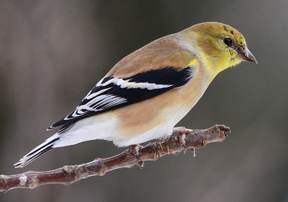It might seem like the American Goldfinches are all gone, but the males are simply hiding in plain sight.

This column appeared in the Recorder and the Gazette on Jan 15 and the Eagle on Jan 18.
Anyone who makes a regular habit of watching birds will recognize that there is a predictable rhythm to the seasons. Winter is the harshest time of year and as a result there are fewer species to look for. At my house, in the month of January, I have managed to see a maximum of 31 different species. Different people living in different places will probably see a smaller number than that, but there may be the occasional yard that has more species to offer.
In the month of May the numbers change dramatically. This is the time of peak northerly migration and the number of species can basically double. All sorts of species flood into the north as the fresh bloom of springtime spreads gradually into Canada. New leaves mean new food for insects and, in turn, new food for birds. The landscape is suddenly decorated with colorful jewels from the tropics and one can barely manage to look anywhere without seeing new faces.
Then, the pendulum swings back in the other direction and autumn sends all of those visitors home. One by one the familiar faces vanish and by the time winter arrives once again you only have the true birds of the north to observe. Sometimes you see a smattering of new species that consider our area to be “south enough,” but the roster is once again quite minimal.
There is, however, one species of bird that only appears to vanish. The American Goldfinch (Spinus tristis) is probably one of the most recognizable birds in North America and images of this species can be found on calendars, shirts, postage stamps, cards, and mailboxes. The bird is so widespread and popular in the United States that it has been nominated as the state bird in New Jersey, Iowa and Washington. Even as I am writing this column I find myself sipping coffee from a mug decorated with the image of a goldfinch perched next to a thistle flower.
The most recognizable individuals are the adult males. The upper portions of their bodies are covered with brilliant yellow feathers. Then, there is the signature black forehead that extends to the middle of the top of the bird’s head. Wings and tail are decorated with a stunning combination of jet black and titanium white and the lower belly is also a pure, bright white. If you see a male goldfinch, there is no doubt whatsoever about its identity.
In the early days of April, before the leaves of the trees unfurl, you can easily spot these brilliant, blazing little birds perched in the bare branches. In the summer, they seem to be everywhere and then when winter arrives they disappear. But this is a ruse! The male goldfinches are still here, but they have opted for a costume change that makes them far less visible.
The American Goldfinch is a gregarious species during the winter months. Large flocks of birds will assemble and then move across the landscape looking for suitable sources of food. In the “wild” they will look for seeds and are especially fond of the small seeds of birch trees. So, it makes sense to do everything possible to keep the peace during a season when there need be no additional conflict to make life any harder than it already is.
That bright yellow plumage is an aggressive costume worn by the males during the breeding season. During the winter, however, there is no need to be so provocative, so the males adopt a plumage that is much more similar to that of the females. This tends to soothe the feelings of the birds and also has the happy coincidence of giving the males a better chance at blending in to their environment. Lots of hungry hawks are constantly on the lookout for food, so it pays to be far less flamboyant in one’s attire.
But if you look closely, and you know what to look for, you can see hints of the fancier breeding plumage of the males. Today’s photo shows an adult male goldfinch in his winter costume. The dazzling black-and-white wings do not change, nor does the color of the tail and the lower belly. However, almost all trace of the black forehead and bright yellow bogy are replaces with a drab olive-brown. Above this bird’s eye there are a couple flecks of black that hint at the position of that black forehead and just above the wing there is a speck of the brilliant yellow that the males are famous for.
Many thanks to Dorothy N. for sending me an email and asking for help to identify the mystery bird at her feeder. It was a male American Goldfinch and it provided the inspiration for today’s column. Thanks also to the freshly installed Birch Perch II for providing the perfect spot for one of these tiny little birds to pause for a portrait. If you have a mystery bird that needs identifying, or a column topic that you would like to request, just send me an email and I’ll do my best to help.